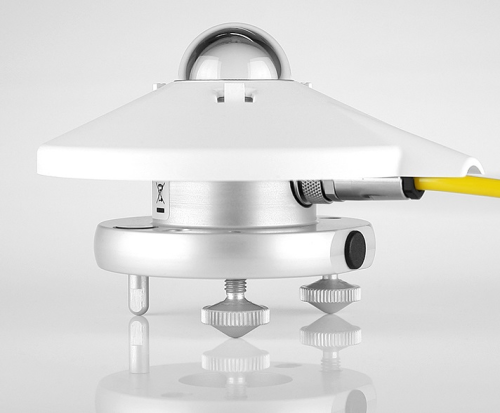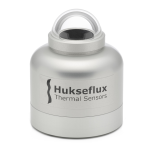
兼容大多数Campbell Scientific数据采集器






概览
CMP3 是 Kipp & Zonen 生产的 ISO二级短波辐射表,它输出毫伏信号,可直接接入到Campbell Scientific数据采集器,广泛应用于气象学领域的太阳辐射测量。
优势与特点
- Includes a white snap-on sun shield that reduces the sensor's temperature
- Measures reflected solar radiation when inverted
- Provides measurements in direct sunlight, under plant canopies, when the sky is cloudy, and in artificial light
- Includes bubble level and leveling screws, eliminating the need for a separate leveling base and simplifying installation
- Acceptable for providing the solar radiation data used in stability estimations
- Dome protects thermopile and allows water to roll off of it
- Designed for continuous indoor and outdoor use
图像



技术说明
CMP3-L以保护在单层玻璃穹顶罩中的高质量黑化热电堆来测量太阳辐射。它在全太阳波段内具有平直的光谱响应,因而适用于冠层下环境、或灯泡光源监测,也适用于多云条件下的太阳辐射监测,还可倒置安装用于监测反射短波辐射。
CMP3-L含有一个直接固定的白色防辐射盖子,用于减小太阳辐射增温。自带的水平泡和可调水平螺丝,使得传感器并不需要额外的调平底座。
CMP3-L产生微伏级信号,可由Campbell Scientific数据采集器直接测量。
两个CMP3-L短波辐射表可以背靠背安装,组成一个经济的反照度表。更多信息请联系Campbell Scientific。
产品规格
| Sensor | Blackened thermopile protected by a dome |
| Measurement Description | Monitors solar radiation for the full solar spectrum range |
| Spectral Range | 300 to 2800 nm |
| Maximum Irradiance | 2000 W/m2 |
| Sensitivity | 5 to 20 µV/W/m2 |
| Operating Temperature Range | -40° to +80°C |
| Temperature Dependence | ±5% (-10° to +40°C) |
| Non-Linearity | < ±2.5% (0 to 1000 W/m2) |
| Tilt Response | < ±2% at 1000 W/m2 (±80°) |
| ISO Classification | Class C (second class) |
| Dome Diameter | 3.2 cm (1.3 in.) |
| Width | 7.9 cm (3.1 in.) |
| Height | 6.7 cm (2.6 in.) |
| Weight | 600 g (1.2 lb) with 10 m (32.8 ft) cable |
兼容性
Please note: The following shows notable compatibility information. It is not a comprehensive list of all compatible products.
数据采集器
| Product | Compatible | Note |
|---|---|---|
| CR1000X (retired) | ||
| CR300 (retired) | ||
| CR3000 (retired) | ||
| CR310 | ||
| CR350 | ||
| CR6 | ||
| CR800 (retired) | ||
| CR850 (retired) |
Additional Compatibility Information
Mounting
The CMP3-L includes a bubble level and adjusting leveling screws, which allow the sensor to be leveled without using a leveling base. The CM225 Solar Sensor Mounting Stand is typically used to attach the sensor to a mast, crossarm, or pole (1.0 in. to 2.1 in. outer diameter). The CM225 consists of a rectangular plate, mounting bracket, U-bolts, washers, lock washers, and nuts. The CMP3-L should be mounted away from all obstructions or reflective surfaces that might adversely effect the measurement.
Alternatively, the CM245 Adjustable Angle Mounting Stand may be used. It includes slots that can be adjusted to any angle from horizontal to vertical.
相关技术文档
常见问题解答
CMP3-L: 6
展开全部收起全部
-
This may be caused by conditions in which the dome of the sensor is warmer than the thermopile. Most users see a small negative value at night. This offset, as it is commonly termed, can be important for monitoring the performance of the sensor.
-
If the dome becomes damaged, contact Campbell Scientific or Kipp & Zonen to discuss replacing the dome. The sensor will need to be sent to Kipp & Zonen for any repairs.
-
The CMP3-L has a passive thermopile that produces a small analog voltage that can be equated to a representative amount of incident solar radiation. Campbell Scientific recommends connecting the leads of the CMP3-L to a Campbell Scientific data logger through a differential analog input terminal.
-
No. The sensor needs to be connected to a data acquisition system, such as a Campbell Scientific data logger.
-
The LP02-L is a sensor manufactured by Hukseflux, whereas the CMP3-L is manufactured by Kipp & Zonen. Both sensors meet the ISO classification of a Second Class pyranometer.
-
Because of the loss of IR radiation, nearly all thermopile instruments typically have a negative offset. This offset is most easily visible at night-time, when a small negative value is read instead of zero. This same offset is present during the daytime, but it is not as visible because of the large solar signal.
Another common issue involves leveling an instrument. Leveling a thermopile instrument can cause errors in the direct beam component because the cosine response is not correct. These errors are more notable when the sun is close to the horizon because the angle is so shallow.

